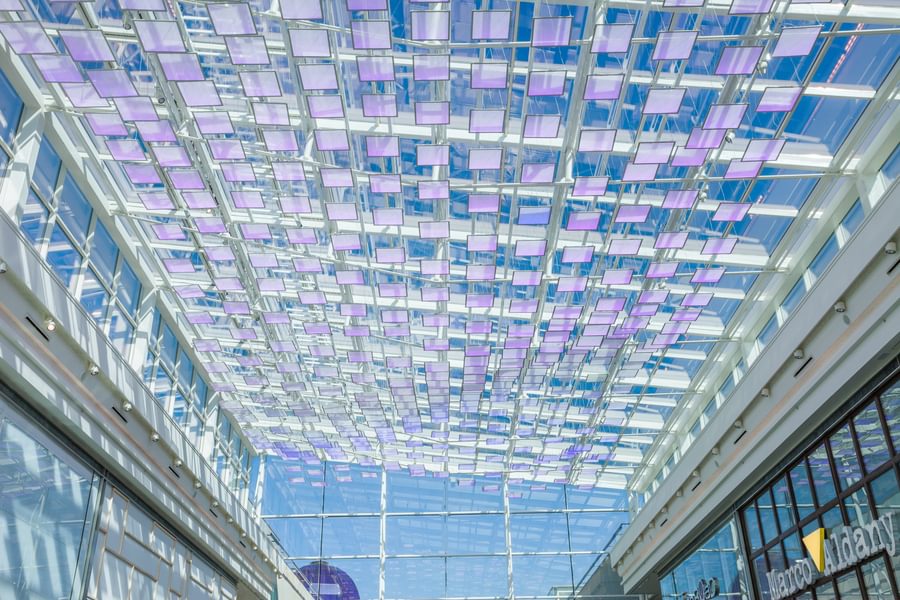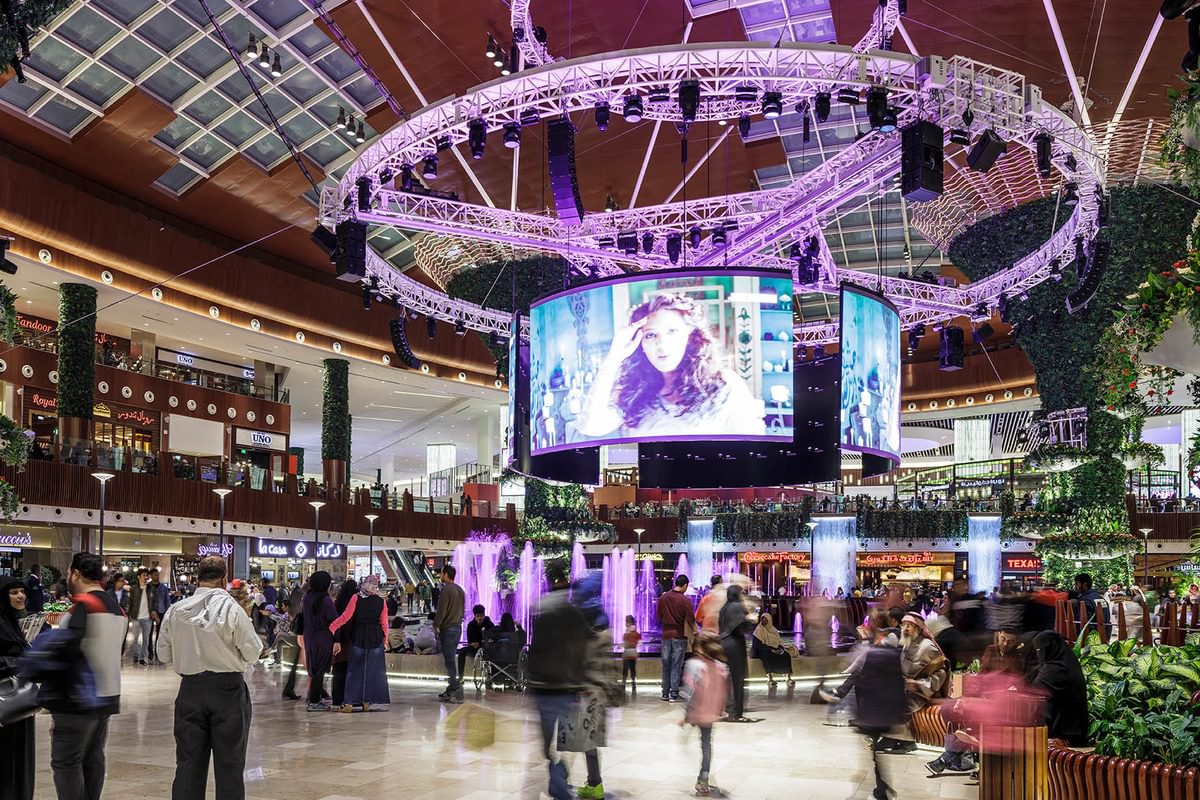
How digital signage and digital artwork can enhance retail and leisure environment
With the retail sector facing a period of upheaval and transformation, competition between retailers is fierce. In this environment, presentation is crucial – shops and shopping centres need to showcase themselves and their products in the best possible way to attract footfall and stay relevant. One way in which that can be done is through the use of digital lighting and signage, which is being used in many retail and leisure developments as lighting, a marketing asset and a design statement. In this Insight paper, we examine the benefits of using digital lighting and signage, the ways in which it is being employed to help create an optimum retail and leisure experience.
Why is Digital being adopted more and more?
Retailers and developers are becoming increasingly likely to incorporate LED lighting and displays, whether installing it in new developments or by way of retrofitting existing ones. Among the reasons for that are:
- Cost: LED lighting can save up to 75% of the cost of traditional fluorescent lighting in terms of maintenance and running costs. The amount of energy required is substantially reduced, as is the frequency with which replacements need to be made. LED can quickly pay for itself.
- Flexibility: Lighting schemes can be adapted to suit the range of products, to change emphasis from one area to another, and to delineate distinctive areas.
- Vibrancy: Digital installations can create a sense of movement and activity, whether through the use of LED artworks, light flows or modular screens. They can create a welcoming, stimulating environment which encourages customer exploration.
- As a design tool: Designers can use digital installations for a range of design purposes, creating artistic centrepieces or decorative effects which enliven the building interior and exterior.
- As a marketing method: Shop displays can deploy LED lighting or information pods to emphasise their products. Shopping centres can use LED to advertise their tenant range.
- Creating an experience: Retail is becoming all about providing an experience, and digital can displays contribute towards that, providing a talking point for visitors.
- Creating a journey: Cinema developments are now using digital installations to create a dramatic visual journey between lobby areas and the theatres, with corridors of dynamic, wraparound LED displays. This helps add to the overall sense of cinematic experience.
- Changing the mood: Lighting can be adapted to suit the time of day – warmer colours in the evening, cooler in the daytime. It can also help create a relaxing atmosphere which is more conducive to lingering and extra spending.
- Sustainability: LED lighting requires only a fraction of the energy to operate compared to fluorescent tubes and other traditional methods of lighting, thus reducing the carbon footprint. The British Council of Shopping Centres, among others, has long advocated that retailers switch to LED for this reason.
Digital Light Cloud Artwork at Rio Plaza 2. The enormous cloud of lights is made up of more than 400 transparent sheets brought to life using a dynamic flow of light that flows over the entire sculpture. Various sensors make the installation interactive and lets visitors to the centre be active participants in the experience.
Ways in which Digital is being incorporated
LED is a versatile method of providing images, colour and light. As its use becomes more prevalent, it is being employed in more and more ways by designers, developers and retailers – often to stunning effect. Prominent among these formats are:
Shopping centre interior lighting
As mentioned, the flexibility of LED lighting allows for its adaptation to suit times of day or the nature of scheduled events, as well as for use in wayfinding. Interior ceilings can be transformed to create the illusion of an open-air experience – it can simulate natural daylight, cloudscapes or a softer twilight – or it can be used to create for other purposes, including dynamic visual content. This can be very useful for creating suitable backdrops for particular events. Previously, traditional lighting methods meant that light might be too harsh or else not bright enough to provide a sense of safety. The adaptability of LED eliminates these problems.
Similarly, LED flooring can help emphasise particular areas or help with wayfinding. It can also simply be used to create a ‘wow’ effect for customers by reacting interactively with their footsteps. Touches like this provide a real talking point and help spread discussion of the shopping centre experience across social media.
Digital welcome screen at Torrecárdenas shopping centre in Almeria, Spain
Exterior design
LED lighting can be an effective tool for drawing attention to the building, particularly from those passing by on nearby roads and motorways. It can also act as a statement – a reflection of the provisions within. For example, more colourful and dynamic exterior displays can be used to target a younger demographic, while more restrained design can help attract an upscale, affluent market.
The overall effect can provide a feeling of community – a place which is alive and buzzing and worth visiting for the experience. It also makes a landmark of the building, memorable and easily recognisable.
Information pods
Both retail centres and individual shops can install LED pods which display information about product ranges – they are designed to be interactive and to assist in the finding and purchasing process. This is a much more flexible advertising format than static displays or billboards, eliminating waste and content redundancy.
Store window displays
For many retail and leisure outlets, the window display is crucial to drawing in custom from outside. LED lighting and screens can help frame a product display in an adaptable way according to what best suits the colour, texture and purpose of those goods. LED screens can also be the product display – showcasing a rotating range of goods in an attractive and engaging way. Screens can be modular in format, meaning that the size of the display can be as big or as small as suits the particular context.
Displays can be programmed or managed from a central position, allowing them to change very quickly according to customer and market movements. This means that, for example, displays can be aimed at mothers and retired people earlier in the day, and at younger people later on.
Visual marketing
Digital screens are a cheap, yet dramatic, medium for video advertising displays. Large displays can form a dramatic feature of shopping centre atriums, creating a focal point and a lucrative advertising space. These can be take the form of immersive displays which surround the viewer, large-scale video walls or dynamic, multi-screen installations. The effect can be dazzling in a way which more traditional forms of advertising cannot achieve.
Social media walls provide a fun method for visitors to comment on products and services, and to provide feedback on their overall experience.
The Mall of Qatar's event stage. When not in use the event stage uses LED screens in the down position to show football games and other advertising content.
Event Backdrops
As the retail experience becomes much more about creating an all-day destination with a mix of other uses (particularly leisure and F&B), event spaces are becoming more important than ever. Whether for promotions, fashion shows, community events or concerts, LED lighting and displays are perfectly suited to create an appropriate backdrop to each event. This enhances the event experience, makes it more likely that the space will be hired and helps create more footfall in the centre.
For more information, please contact:
The recently refurbished Plenilunio shopping centre in Madrid includes 475m² of digital LED technology.
Chapman Taylor has embraced the possibilities afforded by LED technology to transform retail and leisure developments, using it in innovative and spectacular ways to create an environment to which visitors are drawn and kept entertained. From extraordinary corridors wrapped in curved, surrounding LED walls to giant entertainment screens and social media displays, we have worldwide experience in using digital lighting and signage to stunning effect.
For more information, please contact:





